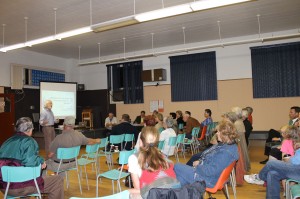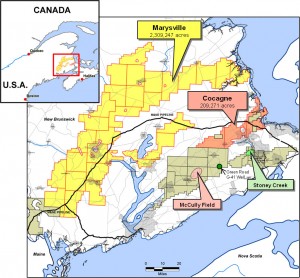Hydro-Fracking Explained at Perth-Andover Presentation

The meeting lasted for nearly four hours, from 7 pm until 11 pm, but nearly everyone who attended stayed until the very end as the speakers were engaging and well informed as they shared their passionate commitment to a better future for all with us.
Upstream Media for Citizens Awareness, a local environmental group, had arranged this public workshop to share information and statistics about ecological and economic issues that New Brunswickers are currently facing regarding the extraction and exploitation of out natural resources.
The presentation began with an in depth exploration of the hydro-fracking process and what it will mean for all New Brunswickers if we allow this industry to be developed in our province.
Jim Emberger is an environmental educator and researcher who at one time was an investigator for the US Federal Energy Administration. He opened with a lengthy and detailed overview of the fracking process and what has happened in other communities that are in or near shale gas deposits that have been extracted using the fracking process.
The information he presented was sobering and even terrifying. Hydro-Fracking is one of the most physically dangerous and environmentally devastating industries being practiced on our world today.
Our current provincial government is forging ahead with plans to develop this industry in NB. Our politicians…and their corporate bosses… have dollar signs in their eyes and are holding out the alluring promise of jobs and economic development, which our province desperately needs.
But at what cost? The evidence is indisputable: Regions that have been opened up to shale gas extraction are utterly devastated.
Agricultural prospects are ruined, the water is contaminated, roads and bridges are destroyed by the heavy traffic, animals and fish die, the air is polluted with carcinogenic toxins and once beautiful land is left barren and ugly.
Add to all this health care costs that will skyrocket. It is an industry statistic that workers in the shale gas industry are at 7 times the risk of injury or death than coal miners, and coal mining is acknowledged as one of the most dangerous jobs on the planet.
The pollution to water, air and land sickens people. Residents in shale gas extraction regions develop many chronic illnesses, including cancer.
As everyone in New Brunswick is painfully aware, our provincial health care system is in trouble. Services are cut back, jobs are eliminated as rural hospitals are eliminated or downsized.
New Brunswick’s hospitals will be overwhelmed with injured gas field workers and residents who have become sick from the toxic pollution they will be exposed to.
Our local river valley communities do not sit over Marcellus shale gas deposits, but that does not mean we will not be affected.
Although the Marcellus shale deposits that the gas industry, and our own government, hope to exploit sit to the east of our beautiful River Valley, almost all of them overlap our fresh water supply.
Nine energy companies hold 71 leases or license agreements that span more than 1.4 million hectares of land. And it’s not just our water that is under threat, these shale gas deposits are all on or near some of our most popular, economically productive and ecologically fragile regions…the Bay of Fundy and the Shediac Beach area are both targeted for hydro-fracking.
While the government and gas companies insist that fracking is a tested method, one that has been practiced for 60 years, this is not exactly true. Conventional natural gas extraction does use hydro-fracking to release natural gas deposits.
However, these conventional deposits were in soft sand stone that was easy to drill, and the gas deposits was all conveniently naturally collected in underground gas domes.
Shale gas extraction has only been around for about 10 years, and no one knows yet just what the ultimate ecological cost of this practice will be.
But the short term costs are stunningly obvious to those of us who care more about our planet, our health, and the wellbeing of the generations to come than a fistful of corporate dollars.
And about all those supposed jobs…fracking is a boom and bust industry, and the work is highly technical. The gas companies will import experienced field workers from out of province to do most of the work, locals will be hired to drive trucks and perform the lowest paid, most menial jobs. And then, a few years down the road when the gas is gone, everyone will pack up and go destroy someplace else, leaving New Brunswick with a toxic mess that will never be cleaned up in our lifetimes.
Shale Gas Quick Facts
 Hydraulic fracturing (‘Fracking’) of rock with water and pressure to release gas has been long used in conventional, gas wells, but to get gas from hard shale, a new combination of techniques are required. Wells are drilled horizontally for many kilometres, massive volumes of water laced with toxic/carcinogenic chemicals are used, and well pads are closely clustered, each containing up to 20 wells. It requires thousands of wells to be drilled and creates an industrialized landscape. This new method is barely more than 10 years old
Hydraulic fracturing (‘Fracking’) of rock with water and pressure to release gas has been long used in conventional, gas wells, but to get gas from hard shale, a new combination of techniques are required. Wells are drilled horizontally for many kilometres, massive volumes of water laced with toxic/carcinogenic chemicals are used, and well pads are closely clustered, each containing up to 20 wells. It requires thousands of wells to be drilled and creates an industrialized landscape. This new method is barely more than 10 years old
Water usage. Each shale gas well pad can have up to 20 wells. Each well can be ‘fracked’ a dozen times or more. Each frack uses 4 millions litres of fresh water. A developed gas field can have thousands of wells.
Wastewater. The water left after a frack is highly toxic and sometimes radioactive. It cannot safely be used for other purposes. All means of disposal have associated problems. The two most popular methods are banned in NB for health and environmental reasons, and currently no method has been selected for disposal.
Chemicals – Amount. The industry says the percentage of chemicals used is small, but because the volume used is so great, the amount of chemicals is great. A frack using 4 million litres of water, of which only 1 percent is chemicals, still results in 40,000 litres of chemicals injected into the earth.
Chemicals – Health. A large portion of the chemicals used in fracking fluid cause serious negative health effects: cancer, damage to brain and nervous systems, immune and cardiovascular systems, kidneys, liver, eyes, skin, respiratory tract, gastrointestinal tract and reproductive system.
Water pollution by chemicals Fracking fluid and other drilling chemicals enter waterways via spills, pipeline breaks, well blowouts, defective well casings, truck accidents and floods. All are regular occurrences everywhere shale gas is produced. Poisoned waters kill farm animals, wildlife, fish and all vegetation.
Air pollution. Shale gas chemicals creates record breaking amounts of ground-level ozone that have been documented as traveling over 300 km from its source. Ozone causes irreparable lung damage. Studies have documented high risk of cancer and other diseases for those living within one half a mile from a gas well.
Poisoned water. Drilling has caused contamination from methane in water wells within a kilometre of a gas well, and by naturally occurring toxic chemicals within 3 km. Fracking chemicals enter water from spills, well blowouts, truck accidents, and wastewater dumping.
Roads, Bridges and Traffic. A single well pad requires thousands of heavy truck trips, operating 24/7, destroying roads and bridges, causing accidents, impacting emergency vehicles and costing millions.
Local Effects. Farming, fishing, hunting, tourism and agriculture will suffer losses. Stress on health care systems will increase. Property values will decrease, and getting mortgages or insurance may be difficult. Cost of living will increase. Shale gas is a boom-bust economy that leaves areas worse off than when they started.
Jobs. Gas rig and drilling jobs are specialized and short term, and will mostly be filled by trained people from elsewhere. Locals will get temporary jobs such as truck drivers and security guards. Shale gas wells generally produce for only a few years, so the industry creates a boom and bust economy.
